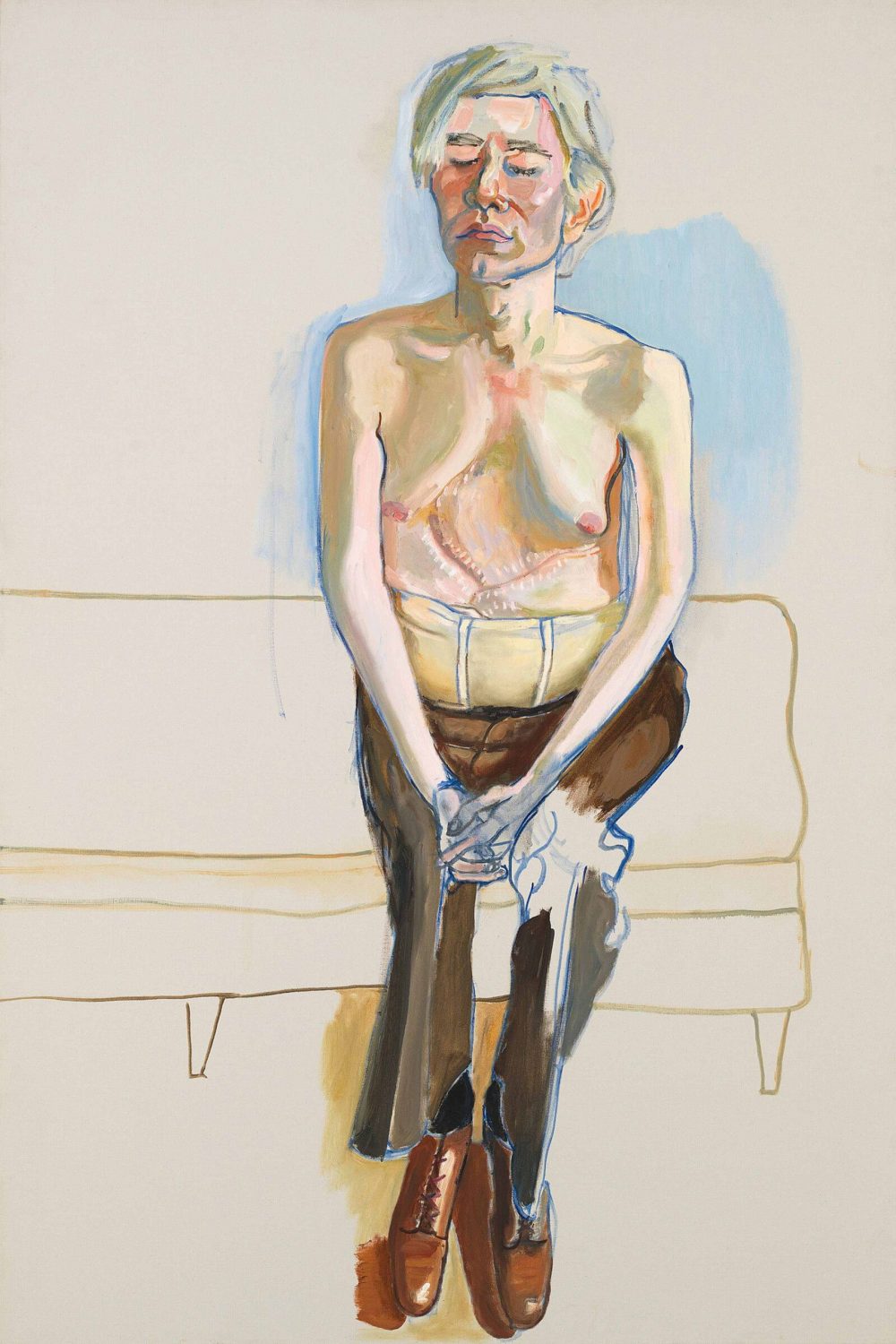At the de Young Museum in San Francisco, I recently saw the Alice Neel retrospective People Come First, which is up through July 10, 2022 and is the first large survey of her work to ever be exhibited on the West Coast. Prior to this show I don’t believe I’d ever seen any of her actual paintings, so I was eagerly anticipating my visit, which would be my first out-of-town trip in well over two years, since shortly before the world closed down. I’ve been a fan of Neel’s for many years, and it seemed her work, with its strongly humanist approach, would be perfectly appropriate for my reentry into the realm of museum-going, which I have missed terribly.
From the mid/late 1980s to the mid-’90s, I was regularly borrowing Patricia Hill’s monograph Alice Neel1 from the Sacramento Public Library. Neel’s painting of Andy Warhol, which appears in the book, is what initially prompted me to do so. I don’t remember where or when I first encountered the piece, but it was almost certainly my introduction to her work. It is a masterful portrait, capturing Warhol as he was rarely seen – sensitive and vulnerable. I actually find it surprising that Warhol sat for her in this way, without the mask of the “Andy Warhol” persona. Unfortunately, the painting is not in the present show; I would have loved to have seen it, although while at the museum, with so much strong work to see, I really didn’t think about what wasn’t there.
The first painting in the exhibition is French Girl, one of Neel’s earliest known extant works,2 done when she was in her early twenties. It’s a stunningly attractive piece, but Alice Neel’s artistic ambitions went far beyond the creation of attractive paintings. Her expressionist bent; her employment of caricature; and her drive to produce work which would reveal something of the inner life of the sitter – to paint what she considered “truth” – often resulted in images which do not fall into traditional notions of beauty. Neel did, however, imbue her sitters with the dignity she believed they all possessed. Her wide range of subjects included family, friends, lovers, leftist political figures, pregnant nude women,3 art world luminaries, feminist leaders, kids from her Spanish Harlem neighborhood, members of the LGBT community, and a Fuller Brush man who was also a Holocaust survivor. Her intent was not only to paint individuals, but also to document the times; her oeuvre, in a sense, is a portrait of the era in which she worked.
In one of the de Young galleries, near the piece Ginny in a Blue Shirt, a monitor shows a short silent film of Neel working on that painting. Although Neel was a straightforward easel painter, I found the film to be a fascinating addendum to the exhibition. She started by outlining the figure and other parts of the image – what she called “dividing up the canvas” – in thinned ultramarine blue oil paint. It’s a startlingly direct method of working, and as a result the sitters display a remarkable presence in the paintings. Neel developed compositions very quickly and if some aspect needed to be adjusted, she simply repainted it.4 She would then fill in color, modeling some areas while keeping others flat. This representational/abstract juxtaposition is heightened by her practice of leaving areas of the picture plane unpainted, as in Ginny in a Blue Shirt and many other pieces done in the latter part of her career. Viewing the work in today’s context, it still looks contemporary and, in the present socio-political climate, her obvious affection for her subjects makes it feel not only current, but revolutionary.
Alice Neel passed away in October of 1984 at the age of eighty-four.
All artwork © The Estate of Alice Neel.
1 Harry N. Abrams, Inc. (1983). In those barbaric pre-internet-shopping days, I was unable to find a copy for purchase until it was reprinted in 1995.
2 In 1934, much of Neel’s early work – about sixty paintings and two hundred drawings and watercolors – was slashed and burned along with her clothing by Kenneth Doolittle, a controlling boyfriend/opium addict. She believed he would have killed her had she not fled their apartment.
3 Neel’s interest in pregnant women, mothers, and children was probably informed by the loss in 1927 of her first baby to diphtheria and the fact that in 1930, her husband abandoned her and took their second child with him to Cuba.
4 She would often leave the initial, “incorrect” lines evident in the finished work, visually flattening those areas.








